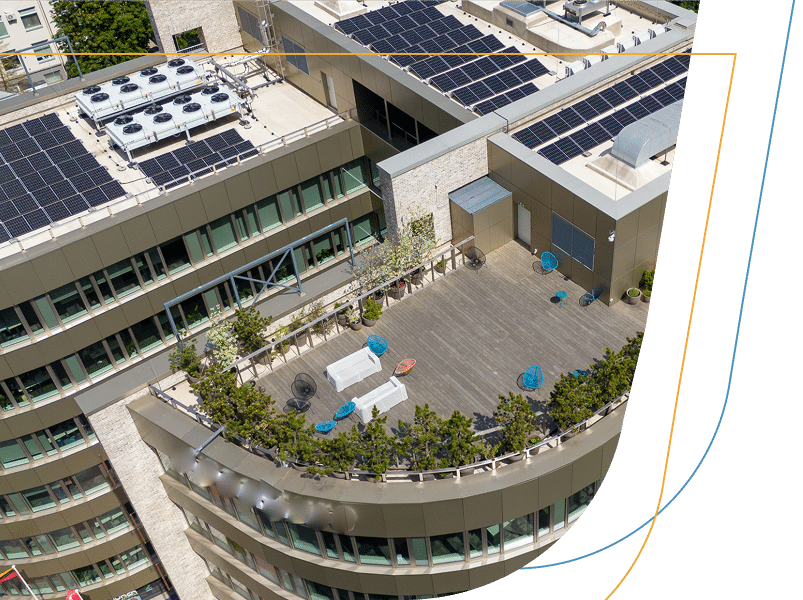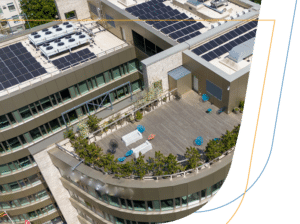

BLOG
Strategic Steps Toward Net Zero in Hospitality: Beyond Immediate Electrification
4/17/25
As governments and industry leaders push toward net zero targets (typically by 2040 or 2050), hotel and resort operators are under pressure to reduce carbon emissions and improve energy efficiency. While full electrification of HVAC systems is a key part of this transition, immediate electrification isn’t always the most practical or cost-effective solution. And because most equipment installed today will be ready for replacement before the net zero deadline, high-efficiency natural gas systems that reduce energy and maintenance costs can support a phased-in approach to achieving net zero.
The reality is that electrification is only one piece of the larger sustainability puzzle. Achieving net zero in hospitality requires a broader, more strategic approach that encompasses asset management, facility planning, and incremental efficiency improvements. By improving energy efficiency now and upgrading systems gradually, hospitality businesses can reduce emissions, lower operating costs, and preserve guest comfort while preparing for a seamless transition to all-electric operations.
The Complexity of Electrification in Hospitality
Hotels, resorts, and other hospitality properties have unique operational and infrastructure challenges that make immediate electrification difficult. Unlike office buildings or residential properties, hotels must provide 24/7 climate control, hot water, and ventilation to ensure guest comfort even during peak demand periods or extreme weather conditions.
Key Barriers to Immediate Electrification:
- High upfront costs – Upgrading from gas-fired to electric heating and hot water systems often requires significant capital investment, including electrical infrastructure upgrades.
- Grid capacity limitations – Many regional electrical grids are not yet equipped to handle the increased demand from widespread electrification.
- Performance issues in colder climates – Electric heat pumps lose efficiency in extreme cold, potentially affecting guest comfort.
- Disruption to operations – Retrofitting existing systems can require downtime, which impacts guest satisfaction and revenue.
- Stranded asset risk – Replacing gas-fired systems before the end of their useful life can lead to wasted capital and increased operating costs.
Why Rushing Electrification Can Backfire
Hotels operate on thin margins, and guest satisfaction is critical to maintaining profitability. A poorly executed electrification strategy can lead to higher operating costs, guest complaints, and financial strain. Instead of focusing solely on electrification, hotel operators need to take a broader view by improving efficiency and asset performance while preparing for a longer-term transition.
A Phased Approach to Building Electrification and Net Zero
Achieving net zero in hospitality doesn’t require an overnight shift to electric heating and cooling. A smarter, more cost-effective strategy involves phased improvements that reduce energy consumption and emissions today while positioning the property for full electrification in the future.
Phase One: Immediate Efficiency Gains with Condensing Boilers and System Upgrades
Before switching to all-electric systems, hotels can achieve significant energy and cost savings by upgrading to high-efficiency equipment such as condensing boilers. While traditional boilers vent hot exhaust gases, wasting heat, condensing boilers capture this waste heat and use it to preheat return water, increasing overall efficiency. Modern condensing boilers achieve efficiencies of up to 98%, compared to 70–80% for older models.
Hotels should also pursue system optimization and modern HVAC controls by installing smart thermostats and building automation systems to fine-tune HVAC performance. Adding heat recovery equipment and upgrading to variable frequency drives (VFDs) on fans and pumps to adjust output based on demand can drastically reduce energy spend.
Phase Two: Hybrid Heating Systems for Flexibility and Resilience
A hybrid heating system combines a condensing boiler with an electric heat pump, allowing the system to switch between gas and electric operation depending on demand and energy prices.
Heat pumps are more efficient in moderate weather, while condensing boilers handle extreme loads. Controls can be programmed to automatically switch to the most cost-effective source of heat. This ensures consistent heating and hot water availability, even during peak periods.
Phase Three: Renewable Energy and On-Site Generation
As grid capacity and renewable energy technology improve, hotels can further reduce their carbon footprint by incorporating on-site renewable energy generation and energy storage.
Rooftop and parking lot solar can offset electricity consumption and reduce grid dependence. And Battery Energy Storage Systems (BESS) store excess solar energy for use during peak demand periods.
Phase Four: Facility Planning and Asset Management for Long-Term Electrification
Successful building electrification and net zero planning require alignment with broader asset management and capital planning strategies such as:
- Lifecycle Planning – Schedule equipment replacements to align with planned electrification milestones.
- Electrical Capacity Upgrades – Expand electrical infrastructure (e.g., transformers, panels) in phases to support future electric systems.
- Strategic Capital Investment – Use utility rebates, tax incentives, and green financing to offset electrification costs.
Phase Five: Full Electrification and Net Zero Operations
By the 2040 or 2050 deadlines, improvements in heat pump technology and grid infrastructure will make full electrification more practical. At this stage, hotels can fully transition to electric heating and hot water systems without sacrificing performance or guest comfort.
Final Steps Toward Full Electrification:
- Replace condensing boilers with electric heat pumps or electric boilers.
- Expand renewable energy capacity to offset 100% of electric demand.
- Implement smart grid integration and load balancing to minimize peak demand costs.
Conclusion: Electrification is a Journey, Not a Race
Achieving net zero in the hospitality industry requires more than a quick switch to electric systems. It demands a strategic, phased approach that balances sustainability with operational performance and financial realities.
By starting with high-efficiency equipment and modern controls, hospitality businesses can reduce emissions and costs today while preparing for a seamless transition to full electrification. Aligning these improvements with asset management and facility planning ensures a smooth path to net zero without sacrificing guest comfort or profitability. With strategic planning and incremental upgrades, the hospitality industry can reach the finish line with stronger, more resilient operations.